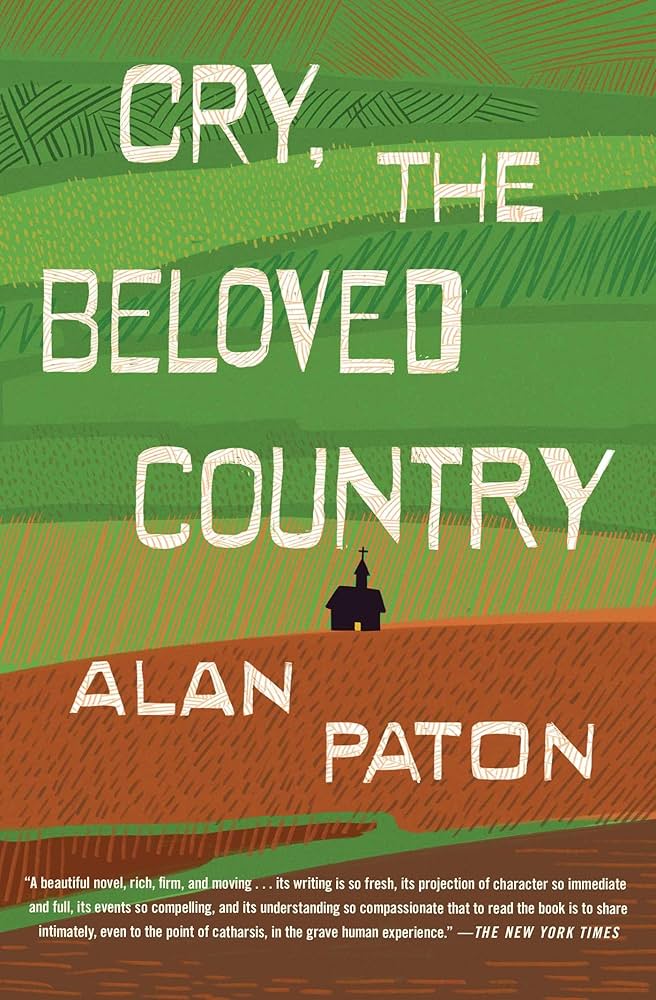In the tapestry of South African literature, few works resonate as profoundly as alan Paton’s ”Cry, the Beloved Country.” With its haunting landscapes and poignant characters, this novel delves deep into the human condition, weaving together threads of hope and heartbreak against the backdrop of a nation in turmoil. Paton’s lyrical prose serves as both a mirror and a window,reflecting the struggles of individuals while opening up broader conversations about social justice,racial inequality,and the enduring spirit of love. In this exploration, we shall navigate the emotional currents that define the narrative, uncovering the myriad ways in which hope and despair intertwine to shape the human experience in a world often fraught with division. Join us as we unravel the complexities of Paton’s masterpiece, examining how its themes resonate with both the past and the present, urging readers to confront the truths of their own hearts amidst the ache of a divided land.
Journey Through the Heart of South Africa in Paton’s Masterpiece

alan Paton’s Cry, the Beloved Country transports readers to the vrey essence of South Africa, revealing a land where hope and heartbreak interweave. Through the vibrant landscapes and tortured lives of his characters, Paton paints a vivid picture of a nation in turmoil. The journey of Reverend Stephen Kumalo encapsulates the struggle against the backdrop of social injustice and personal loss. This heartfelt pilgrimage leads him across stunning terrains, where the contrast between beauty and despair signifies the complex fabric of South African society.
As the narrative unfolds, key themes emerge that resonate deeply with the human experience.Among them are:
- Redemption: The search for forgiveness amidst the chaos of life.
- Unity: The interlinked fates of individuals in a fractured society.
- Faith: The enduring power of belief in the face of despair.
- Loss: The universal pain of grief and separation.
Paton’s eloquent prose speaks to the heart, connecting readers not just to characters but to a broader narrative of resilience. his portrayal of Johannesburg stands as a symbol of both hope and despair, reflecting the potential for change amid overwhelming challenges. Here, the land itself becomes a character—a witness to the trials and tribulations of its people, embodying the struggle for dignity and identity in a changing world.
Understanding the Landscape of Despair and Redemption in the Novel

The stark contrast between despair and redemption serves as a powerful backdrop in Alan Paton’s ’Cry,the Beloved Country’. Through the eyes of his protagonist,Stephen Kumalo,Paton delves deep into the challenges faced by individuals and communities in a land ravaged by social injustices and personal loss. As Kumalo journeys from his rural home to the chaotic streets of Johannesburg, the emotional landscape reflects not only his grief and despair but also the collective suffering of his compatriots. Key themes emerge as the narrative unfolds, illustrating the fragmented relationships within families and the broader societal disconnection stemming from apartheid-era struggles. In this context, despair manifests as a feeling of helplessness, embodied in the lives of characters affected by the city’s allure and its destructive consequences.
Yet, amid the shadows of hopelessness, glimmers of redemption begin to shine, frequently enough found in the unyielding connections between people. As Kumalo encounters characters like the compassionate Msimangu and the resilient Absalom, the narrative highlights the vital role of community and forgiveness in seeking salvation. These interactions encapsulate the potential for healing, suggesting that even in the depths of sorrow, relationships can be the catalyst for change. Ultimately, the novel propels readers to grapple with the notion that while despair is a powerful force, the journey toward redemption is equally potent, underscored by the resilience of the human spirit as it strives for hope and reconciliation.
| theme | Description |
|---|---|
| Despair | A representation of individual and collective suffering |
| Redemption | The transformative power of community and forgiveness |
| Hope | Emerging from human connections and relationships |
Character Depth: the Resilience and Vulnerability of Stephen Kumalo
Stephen Kumalo embodies a rich tapestry of resilience and vulnerability, making him a deeply resonant character in the narrative. His journey from the tranquil village of Ndotsheni to the bustling city of Johannesburg reveals the profound challenges that shape his character. As he navigates the chaos of urban life, Kumalo faces the agony of family disintegration, witnessing the haunting effects of apartheid. This struggle unveils his inner strength as he persists in seeking his son,Absalom,despite the overwhelming odds. Kumalo’s unwavering commitment to family and morality stands as a testament to the enduring power of hope even in dire circumstances. His resilience serves not just as a personal trait but as a reflection of a broader cultural struggle against adversity.
However, it is Kumalo’s external vulnerability that draws the reader’s empathy.His raw emotions surface as he confronts both his personal losses and societal injustices. The weight of grief intermingles with guilt, notably as he grapples with his faith and the perceived failures of his parenting. This duality of strength and frailty manifests beautifully in moments of introspection, where the reader sees a man unafraid to confront his own shortcomings. Through his journey, Kumalo becomes a symbol of the universal human experience of persevering through pain, embodying hope amidst heartbreak in a world that often seems unforgiving.
The Role of Music and Spirituality in Uniting Souls Across Divide

Spirituality, woven into the narrative’s fabric, enhances the theme of unity as it invokes a sense of belonging and purpose. As characters grapple with loss, forgiveness, and the quest for redemption, they find solace in moments of prayer, contemplation, and reflection, reminding readers of the divine connection that links us all. This exploration of faith emphasizes that regardless of worldly divides, there exists a profound bond facilitated by shared beliefs and the pursuit of a more compassionate existence. The ability of both music and spirituality to heal and inspire serves as a powerful testament to their role in bridging divides and fostering unity, even in the face of heartbreak.
Exploring Themes of Injustice and Social Inequality in the Narrative

Alan Paton’s poignant narrative unfolds within the fractious landscape of south Africa, where the specter of injustice looms large. Through characters like Stephen Kumalo and his son Absalom,Paton eloquently showcases the struggles against systemic oppression and racial segregation. The stark contrasts of urban and rural environments mirror the deep social divides, threading a rich tapestry of despair and resilience. Glaring injustices faced by the black community, including displacement, indifference, and violence, are palpable throughout the story, prompting readers to reflect on the structures that perpetuate inequality. This profound exploration resonates beyond the pages, challenging the audience to confront the consequences of social inequity and consider the human cost of collective silence.
The juxtaposition of despair and hope within the narrative highlights the complexity of human existence amid deep-rooted societal flaws. Characters grapple not only with inner turmoil but also with the wider implications of their circumstances. This is clearly seen in the contrasting experiences of those who wield power against the marginalized. The emotional weight of the story is encapsulated in the relationships formed through shared suffering and solidarity. By illustrating the interconnectedness of personal and communal journeys, Paton compels readers to acknowledge that the fight against injustice is not merely a political stance but a deeply personal mission. To better understand these dynamics, the table below summarizes key characters alongside their symbolic representations of social inequality:
| Character | Symbolism |
|---|---|
| Stephen Kumalo | Hope amidst despair |
| Absalom Kumalo | The consequences of choices |
| James Jarvis | Redemption and understanding |
| Gertrude Kumalo | Despair and lost potential |
The Contrast of Urban and Rural Life: A Symbolic Framework

the rich tapestry of urban and rural life in Alan Paton’s narrative serves as a poignant backdrop for exploring profound human experiences. In the rural provinces of South Africa, the land itself symbolizes hope, embodying the connection to heritage and the rhythms of life long forgotten in the bustling cities.Nature’s serene landscape and quietude contrast sharply with the cacophony of urban life, where disillusionment brews amid the chaos of poverty, crime, and social inequality.
This duality is not merely a setting but a symbolic framework that reflects the struggles and aspirations of its characters. Rural life is depicted as a cradle of tradition, where values nurture community bonds, while urban existence exposes individuals to the harsh realities of socio-economic challenges. The stark differences are illustrated through:
- Tradition vs. Modernity: The rural character’s adherence to customs clashes with urban characters’ pursuit of progress.
- connection vs. Isolation: The close-knit rural community contrasts with the alienation found in the cities.
- Hope vs. Despair: While the land provides a source of inspiration, the city frequently enough engenders a sense of hopelessness.
Imagery and Symbolism: Nature as a Character in Itself

In Alan Paton’s poignant narrative, nature transcends its physical form to become a vital character, embodying the emotions and struggles of the people. The rolling hills, stark landscapes, and desolate streets of South Africa serve not just as a backdrop but as integral players in the story of hope and heartbreak. The imagery conjured through descriptions of the landscape frequently enough reflects the internal turmoil of the characters; for example, the lush green of the valleys stands in stark contrast to the parched earth that symbolizes despair and desolation. This striking dichotomy invites readers to consider the land as a mirror to the human experience, where every change in weather and scenery echoes the characters’ emotional states.
Moreover,the symbolism carried by natural elements deepens the exploration of themes such as connection and disconnection. The presence of the river, which runs through the heart of the narrative, represents both a life-giving force and a dividing line between communities. This duality serves to illustrate the fragility of unity amidst conflict and the persistent yearning for reconciliation. In moments of joy, the sunlit plains evoke a sense of warmth and nurturing, while in times of sorrow, the oppressive darkness of the night sky looms ominously, echoing the weight of loss and mourning. Such vivid depictions encourage readers to reflect on how the natural world profoundly influences human relationships, becoming a silent witness to the unfolding drama of social and emotional strife.
The Power of Forgiveness: Healing Wounds of the Past
Within the pages of “Cry, the Beloved Country,” forgiveness emerges as a vital theme, woven intricately into the healing process of its characters. Alan Paton paints a poignant picture of a fractured society, where the wounds of apartheid and personal loss can feel insurmountable. throughout the narrative, we witness how forging connections through compassion can lead to personal liberation. The act of forgiving not only mends the rifts between individuals but also catalyzes societal reconciliation, propelling the narrative toward hope amid despair.Paton illustrates that while the past holds tremendous weight,the future can pivot on the choice to forgive.
In examining the relationship between forgiveness and healing, we can draw from the following reflections found in the text:
- Self-Rediscovery: Characters find strength through the realization that holding onto anger serves only to further entrench their suffering.
- Rebuilding Community: The journey toward forgiveness fosters a sense of unity and shared purpose among a disjointed community.
- Personal Growth: The narrative underscores that the freedom obtained through forgiveness allows for personal and collective progress.
| Character | Journey of Forgiveness |
| Stephen Kumalo | From despair to hope through understanding and mercy. |
| James Jarvis | Transforms grief into action through acceptance and compassion. |
The Impact of Historical Context on the Characters’ Journeys
In Alan Paton’s poignant narrative, historical context serves as a powerful backdrop that shapes the characters’ journeys, illuminating their struggles and triumphs against the unforgiving landscape of apartheid-era South Africa. The societal fractures and systemic injustices compel characters like Stephen Kumalo and James Jarvis to grapple with their own beliefs and experiences. As they navigate the complexities of their interwoven lives, the weight of their historical circumstances amplifies their personal conflicts and moral dilemmas. The impact of racial division not only molds their identities but also catalyzes a transformative quest for redemption and understanding.This socio-political milieu fosters a profound sense of hopelessness yet together kindles a hope that transcends their immediate realities.
Characters such as Kumalo embody the struggles of a people yearning for connection and reconciliation in the face of deep-seated despair. Encountering loss and disillusionment, their journeys reflect the broader narrative of a nation at a crossroads. Through their stories, Paton artfully demonstrates how historical context influences personal growth, shaping the decisions they make and the relationships they forge. This cyclical interplay can be briefly summarized in the table below:
| Character | Historical Influence | Journey Outcome |
|---|---|---|
| Stephen Kumalo | Struggling under apartheid’s oppression | Quest for reconciliation |
| James jarvis | Confronting white privilege | Path to understanding |
| Absalom Kumalo | Victim of systemic inequality | Tragic choices made |
Emotional Nuances: Love and loss in Relationships
Within the pages of Alan Paton’s poignant novel, the intricate tapestry of relationships is woven with threads of love and loss. The protagonists, particularly Stephen Kumalo, navigate through the emotional landscape of familial bonds and societal decay. His journey back to his homeland is punctuated by a profound sense of longing for connection, not just to his family, but to the larger tapestry of community that has been frayed by systemic injustices. The love he holds for his son,Absalom,is both a source of hope and a harbinger of heartbreak,showcasing how deeply personal emotions are often intertwined with the struggle against external circumstances. This nuanced portrayal of love highlights the tender yet tenuous nature of human relationships, illuminating the delicate balance between joy and sorrow.
As Kumalo faces the haunting reality of loss,the novel juxtaposes personal grief with the collective suffering of a nation.The emotional weight of losing a loved one resonates through the story, revealing how such losses ripple across the fabric of society. In his interactions with other characters, including the anguished father of the man his son has killed, the theme of shared grief emerges, creating a space for understanding and empathy amid the despair. The interplay of hope and hopelessness can also be reflected in the following table, illustrating key emotional turning points in the narrative that emphasize the duality of love and loss:
| Emotional moment | Meaning |
|---|---|
| Finding of Absalom’s crime | Shatters Kumalo’s world, introducing deep sadness. |
| Reunion with family | Offers a fleeting moment of hope amidst despair. |
| Sharing grief with Mr. Jarvis | Building a bridge of understanding between two fathers. |
Paton’s Prose: A Blend of poetic Elegance and Gritty Realism

Alan Paton’s narrative style effortlessly weaves together the threads of poetic elegance and stark realism, creating a tapestry that reflects the complex tapestry of South African society. His prose is characterized by a profound sensitivity to the human condition, where each sentence resonates with a lyrical quality that captures fleeting moments of beauty amidst gripping landscapes of despair. In ‘Cry,the Beloved country’,paton employs vivid imagery that not only conveys the physical settings but also mirrors the internal struggles of his characters,offering readers a glimpse into the soul of a nation fraught with turmoil.
At the core of Paton’s writing lies an exploration of universal themes such as hope, loss, and the enduring quest for redemption. Through the experiences of the protagonist, Stephen Kumalo, who traverses a world torn apart by apartheid, readers are invited to confront a reality steeped in both adversity and resilience. The stark contrast between the harshness of the characters’ lives and the beauty of Paton’s prose serves to amplify the emotional depth of the narrative. This juxtaposition not only highlights the gritty truths of life in South Africa but also underscores an unwavering spirit—one that seeks harmony in a fractured world.
| Element | Description |
|---|---|
| Poetic Imagery | Vivid descriptions that evoke emotional responses. |
| Character Struggles | Complexities of personal and societal conflicts. |
| Themes | Hope, loss, redemption deeply interwoven. |
Lessons on Empathy and Humanity: A Reflection for Modern Readers
In Alan Paton’s poignant narrative,readers are invited to explore the essence of humanity through the lens of both heartbreak and hope. The deep ties that bind characters to one another reveal the fragile threads of empathy that hold society together. as we navigate through the landscape of South Africa,we witness how love can flourish even in desolation. The transformative power of understanding is palpable, as it urges us to embrace our shared experiences and recognize the humanity in others, regardless of the societal divides that may exist.
This exploration evokes a call to action for modern readers to reflect on their own capacity for empathy. Through the characters’ struggles and triumphs, we glean essential lessons on the importance of seeing beyond differences, fostering connections, and extending kindness. Below are key takeaways that resonate with the challenges faced in today’s world:
| Lesson | Application |
|---|---|
| Understanding others’ pain | Engage in active listening |
| Forgiveness | Let go of grudges |
| Solidarity | Support marginalized voices |
| Hope in adversity | Seek out positive narratives |
Throughout his work, Paton highlights that compassion is the bridge that can connect disparate lives, and by embracing empathy, we not only enrich our own lives but also affect meaningful change in the communities we inhabit. As readers, it is our obligation to carry these lessons forward, allowing the echoes of Paton’s words to inspire us to forge deeper connections in our modern, often fragmented world.
Why Every Reader Should Engage with This Timeless Work Today

Engaging with alan Paton’s masterpiece offers readers a chance to immerse themselves in a complex narrative that resonates even today. The themes of hope and heartbreak provide a profound reflection on the human condition and the harsh realities of life. By diving into this timeless work, readers can explore:
- The Power of Forgiveness: Discover how reconciliation can pave the way for healing.
- Societal Commentaries: Reflect on the injustices and struggles that persist in modern times.
- Universal Emotions: Experience the depth of love, loss, and resilience that transcends cultural boundaries.
Moreover,the beautifully crafted prose invites readers to appreciate the art of storytelling at its finest.Through the lens of Paton’s characters, you will witness:
| character | Thematic Relevance |
|---|---|
| Stephen kumalo | Embodies the search for redemption and understanding amidst adversity. |
| Absalom Kumalo | Symbolizes the generational divide and the consequences of societal neglect. |
Ultimately, engaging with Paton’s narrative allows readers to not only experience but also question their own values and beliefs, fostering a deeper understanding of themselves and the world around them.
Alan Paton’s Enduring Legacy: A Voice for Justice and Compassion
Alan Paton’s profound exploration of the human spirit in “Cry, the Beloved Country” transcends time and continues to resonate with readers around the globe. His vivid portrayal of South Africa’s struggle during apartheid serves as a powerful reminder of the enduring battle for justice and compassion.Through the characters of Kumalo and Jarvis, Paton shines a light on the shared suffering and interconnectedness of humanity, amplifying the urgent need for understanding and healing. Each character’s journey encapsulates the universal themes of loss, redemption, and the possibility of hope amidst despair, urging us to confront our own roles in fostering a more just society.
The legacy of paton is encapsulated in several key aspects that continue to inspire and challenge us today:
- Humanity’s Fragility: paton’s narrative reminds us that vulnerability is a shared human condition.
- Advocacy for Social justice: His work pushes against the moral complacency of society, calling for active participation in the fight against inequity.
- Empathy and Understanding: by emphasizing the emotional and moral dilemmas faced by his characters, he underscores the importance of compassion in resolving conflicts.
Closing Remarks
In “‘,” we traverse the intricate landscape of human emotion, where hope intertwines with despair against the backdrop of a divided nation.Paton’s masterful storytelling invites readers to reflect not only on the struggles of his characters but also on the broader human experience. As we close this chapter on our exploration, we are left with profound insights into resilience and the transformative power of compassion. The echoes of Paton’s poignant narrative resonate within us, urging us to carry forward the lessons of empathy and understanding. In a world still grappling with its own challenges, “Cry, the Beloved Country” remains a timeless reminder that even in the depths of heartbreak, the seeds of hope can blossom when nurtured with love and understanding.With this in mind, we part ways with Paton’s world, but we do so inspired to seek our own path toward healing and unity in our lives.












